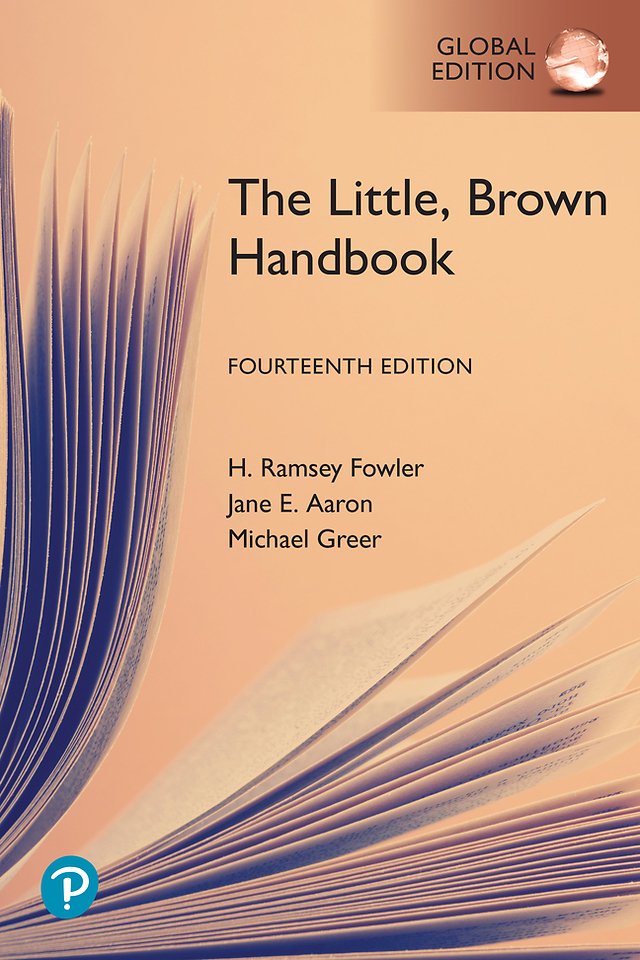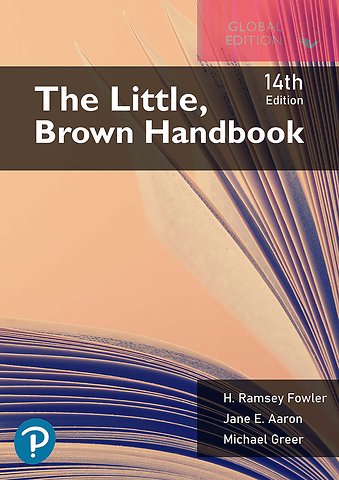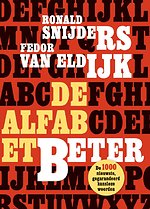Little, Brown Handbook, The, Global Edition
Paperback Engels 2022 14e druk 9781292441191Samenvatting
For courses in English Composition. The platinum standard of handbooks — unmatched in accuracy, currency, and reliability The Little, Brown Handbook is an essential reference tool designed to help students find the answers they need quickly and easily.
While keeping pace with rapid changes in writing and its teaching, this meticulous handbook combines comprehensive research and documentation with grammar coverage that is second to none. Incorporating detailed discussions of critical reading, media literacy, academic writing, argument, and much more, The Little, Brown Handbook is an accurate, reliable, and accessible resource for writers of varying experience levels and in a variety of fields.
The 14th Edition includes over 90 new student samples, new learning objectives, updates to MLA and Chicago style, a new chapter on writing about literature, and more. The Little, Brown Handbook is also available via RevelTM, an interactive learning environment that enables students to read, practice, and study in one continuous experience. Learn more about Revel.
Specificaties
Lezersrecensies
Inhoudsopgave
1-Assessing the Writing Situation
-1.1 How Writing Happens
-1.2 The Writing Situation
-1.3 Audience
-1.4 Purpose
-1.5 Subject
-1.6 Genre and Medium
2-Discovering and Shaping Ideas
-2.1 Invention
-2.2 Thesis
-2.3 Organization
-Sample Informative Essay
3-Drafting, Revising, and Editing
-3.1 First Draft
-Sample First Draft
-3.2 Revising
-3.3 Peer Review
-3.4 Sample Revision
-Sample Revised Draft
-3.5 Editing
-3.6 Final Draft
-Sample Final Draft
4-Writing and Revising Paragraphs
-4.1 Flow
-4.2 Unity
-4.3 Coherence
-4.4 Development
-4.5 Introductions, Conclusions, and Transitions
5-Presenting Writing
-5.1 Academic Writing
-5.2 Visuals and Media
-5.3 Writing Online
-Sample Literacy Narrative Blog Post
-5.4 Oral Presentations
-Sample Presentation Slides
-5.5 Portfolios
II. Reading and Writing in and out of College
6-Writing in Academic Situations
-6.1 Purpose and Audience
-6.2 Genre
-6.3 Writing with Sources
-6.4 Academic Language
-6.5 Communication in Academic Settings
7-Critical Reading and Writing
-7.1 Critical Thinking
-7.2 Techniques of Critical Reading
-7.3 Summarizing
-7.4 Critical Response
-7.5 Visual Analysis
-7.6 Writing a Critical Analysis
-7.7 Sample Critical Responses
-Sample Critical Analysis of a Text
-Sample Critical Analysis of a Visual
8-Reading Arguments Critically
-8.1 The Elements of Argument
-8.2 Claims
-8.3 Evidence
-8.4 Reliability
-8.5 Assumptions
-8.6 Language and Tone
-8.7 Fallacies
-8.8 Visual Arguments
9-Writing an Argument
-9.1 Subject
-9.2 Thesis, Purpose, and Audience
-9.3 Reasoning
-9.4 Evidence
-9.5 Engaging Readers
-9.6 Organizing and Revising
-9.7 Sample Argument
-Sample Proposal Argument
10-Taking Essay Exams
-10.1 Preparing
-10.2 Planning
-10.3 Writing
-Sample Essay Exam Answer
11-Public Writing
-11.1 Social Media
-11.2 Letters and Memos
-Sample Business Letter
-Sample Memo
-11.3 Job Applications
-Sample Job Application Letter
-Sample Résumés
-11.4 Reports and Proposals
-Sample Report and Proposal
-11.5 Community Service
-Sample Social-Media Post
III. Grammatical Sentences
12-Understanding Sentence Grammar
-12.1 Sentence Basics
-12.2 Sentence Patterns
-12.3 Single-Word Modifiers
-12.4 Word Groups
-12.5 Compound Constructions
-12.6 Inverted Order
-12.7 Sentence Types
13-Case of Nouns and Pronouns
-13.1 Subjective, Objective, and Possessive Cases
-13.2 Compound Subjects and Objects
-13.3 Common Questions about Case
14-Verbs
-14.1 Verb Forms
-14.2 Easily Confused Verb Forms
-14.3 Verb Endings
-14.4 Helping Verbs
-14.5 Verbs with Gerunds and Infinitives
-14.6 Verbs with Particles
-14.7 Verb Tenses
-14.8 Sequence of Tenses
-14.9 Subjunctive Mood
-14.10 Active and Passive Voice
15-Agreement
-15.1 Subject-Verb Agreement
-15.2 Unusual Word Order
-15.3 Subjects Joined by Conjunctions
-15.4 Indefinite and Relative Pronouns
-15.5 Collective and Plural Nouns
-15.6 Pronoun-Antecedent Agreement
16-Adjectives and Adverbs
-16.1 Functions of Adjectives and Adverbs
-16.2 Comparative and Superlative Forms
-16.3 Double Negatives
-16.4 Nouns as Modifiers
-16.5 Determiners
IV. Clear Sentences
17-Sentence Fragments
-17.1 Identifying Fragments
-17.2 Correcting Fragments
-17.3 Common Types of Fragments
-17.4 Acceptable Fragments
18-Comma Splices and Fused Sentences
-18.1 Identifying Comma Splices and Fused Sentences
-18.2 Correcting Comma Splices and Fused Sentences
19-Pronoun Reference
-19.1 Clear Reference
-19.2 Close Reference
-19.3 Specific Reference
-19.4 Appropriate You, Who, Which, and That
20-Shifts
-20.1 Types of Shifts
-20.2 Person and Number
-20.3 Tense and Mood
-20.4 Subject and Voice
-20.5 Direct and Indirect Quotations and Questions
21-Misplaced and Dangling Modifiers
-21.1 Clear Placement
-21.2 Limiting Modifiers
-21.3 Squinting Modifiers
-21.4 Separated Subjects, Verbs, and Objects
-21.5 Separated Infinitives and Verb Phrases
-21.6 Position of Adverbs
-21.7 Order of Adjectives
-21.8 Dangling Modifiers
22-Mixed and Incomplete Sentences
-22.1 Mixed Grammar
-22.2 Mixed Meaning
-22.3 Incomplete Compounds
-22.4 Incomplete Comparisons
-22.5 Careless Omissions
V. Effective Sentences
23-Emphasizing Ideas
-23.1 Subjects and Verbs
-23.2 Subject Beginnings and Endings
-23.3 Parallel Elements
-23.4 Repetition and Separation
-23.5 Conciseness
24-Using Coordination and Subordination
-24.1 Coordination
-24.2 Subordination
-24.3 Connecting Words
25-Using Parallelism
-25.1 Understanding Parallelism
-25.2 Equal Elements
-25.3 Coherence
26-Achieving Variety
-26.1 Sentence Length and Structure
-26.2 Sentence Beginnings
-26.3 Word Order
VI. Punctuation
Chart: Commas, Semicolons, Colons, Dashes, and Parentheses
27-End Punctuation
-27.1 Period
-27.2 Question Mark
-27.3 Exclamation Point
28-The Comma
-28.1 Uses of the Comma
-28.2 Main Clauses Linked by Conjunctions
-28.3 Introductory Elements
-28.4 Nonessential Elements
-28.5 Series and Coordinate Adjectives
-28.6 Quotations and Other Conventional Uses
-28.7 Unnecessary Commas
29-The Semicolon
-29.1 Main Clauses without Coordinating Conjunctions
-29.2 Main Clauses with Transitional Words
-29.3 Main Clauses That Are Long or Contain Commas
-29.4 Items in a Series
-29.5 Unnecessary Semicolons
30-The Apostrophe
-30.1 Possession
-30.2 Contractions and Abbreviations
31-Quotation Marks
-31.1 Direct Quotations
-31.2 Titles of Works
-31.3 Words Used in a Special Sense
-31.4 With Other Punctuation
32-Other Punctuation Marks
-32.1 Colon
-32.2 Dash
-32.3 Parentheses
-32.4 Brackets
-32.5 Ellipsis Mark
-32.6 Slash
VII. Mechanics
33-Capitals
-33.1 Conventions
-33.2 First Word of Sentence
-33.3 Titles and Subtitles
-33.4 Proper Nouns and Proper Adjectives
34-Italics or Underlining
-34.1 Titles of Works
-34.2 Foreign Words and for Emphasis
35-Abbreviations
-35.1 Abbreviations in Nontechnical Writing
-35.2 Misuses of Abbreviations
36-Numbers
-36.1 Numerals and Words
-36.2 Dates and Addresses
VIII. Effective Words
37-Using Appropriate Language
-37.1 Standard English
-37.2 Texting and Electronic Shortcuts
-37.3 Slang, Colloquialisms, Regionalisms, and Jargon
-37.4 Indirect or Pretentious Writing
-37.5 Sexist and Biased Language
38-Using Exact Language
-38.1 Dictionary, Thesaurus, and Spelling Checker
-38.2 Denotation and Connotation
-38.3 Abstract and Concrete Words
-38.4 Idioms
-38.5 Figurative Language
-38.6 Trite Expressions
39-Writing Concisely
-39.1 Achieving Conciseness
-39.2 Subjects and Verbs
-39.3 Empty Words and Phrases
-39.4 Unnecessary Repetition
-39.5 Other Strategies
40-Spelling and the Hyphen
-40.1 Common Spelling Problems
-40.2 Spelling Rules
-40.3 Spelling Skills
-40.4 Hyphenating Words
IX. Research Writing
41-Planning a Research Project
-41.1 The Process of Research Writing
-41.2 Research Questions
-41.3 Research Strategies
-41.4 Working Bibliographies
-Sample Annotated Bibliography Entry
42-Finding Sources
-42.1 Search Strategies
-42.2 Reference Works
-42.3 Books and Periodicals
-42.4 Web Search Strategies
-42.5 Social Media
-42.6 Government Publications
-42.7 Visuals and Media
-42.8 Primary Research
43-Working with Sources
-43.1 Interacting with Sources
-Sample Annotated Source
-43.2 Evaluating Sources
-43.3 Synthesizing Sources
-43.4 Summary, Paraphrase, and Quotation
-43.5 Integrating Sources
44-Avoiding Plagiarism
-44.1 Defining Plagiarism
-44.2 Information You Do Not Need to Cite
-44.3 Information You Must Cite
-44.4 Documenting Sources
-44.5 Copyright and Permissions
45-Writing the Paper
-45.1 Developing a Thesis
-45.2 Organizing Your Ideas
-45.3 Drafting a Research Paper
-45.4 Revising and Editing
-45.5 Preparing a Final Draft
46-Using MLA Documentation and Format
-46.1 In-text Citations
-46.2 List of Works Cited
-46.3 MLA Paper Format
47-Two Research Papers in MLA Style
-47.1 Sample Research Paper in MLA Style
-“The Dream of Sustainable Agriculture”
-47.2 Sample Literary Research Paper in MLA Style
-“Intersecting Race and Gender in Angelia Weld Grimké’s Rachel”
X. Writing in the Academic Disciplines
48-Reading and Writing about Literature
-48.1 The Methods of Literary Analysis
-48.2 Writing Assignments in Literature
-48.3 The Tools and Language of Literary Analysis
-48.4 Citing Sources When Writing about Literature
-48.5 Writing a Literary Analysis
-Sample Literary Analysis
49-Writing in Other Humanities
-49.1 Methods and Evidence
-49.2 Common Writing Assignments
-49.3 Tools and Language
-49.4 Documenting Sources
-49.5 Paper Format
50-Writing in the Social Sciences
-50.1 Common Genres in the Social Sciences
-50.2 Research Conventions in the Social Sciences
-50.3 In-text Citations in APA Style
-50.4 References in APA Style
-50.5 Research Paper Format in APA Style
-50.6 Sample Research Paper in APA Style
-“Perceptions of Mental Illness on College Campuses”
51-Writing in the Natural and Applied Sciences
-51.1 Methods and Evidence
-51.2 Common Writing Assignments
-51.3 Tools and Language
-51.4 CSE Style
-51.5 Paper Format
-51.6 Sample Paper
-“Caterpillar Defense Mechanisms”
Vaak samen gekocht
Anderen die dit boek kochten, kochten ook
Rubrieken
- advisering
- algemeen management
- coaching en trainen
- communicatie en media
- economie
- financieel management
- inkoop en logistiek
- internet en social media
- it-management / ict
- juridisch
- leiderschap
- marketing
- mens en maatschappij
- non-profit
- ondernemen
- organisatiekunde
- personal finance
- personeelsmanagement
- persoonlijke effectiviteit
- projectmanagement
- psychologie
- reclame en verkoop
- strategisch management
- verandermanagement
- werk en loopbaan









